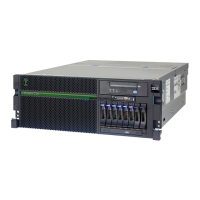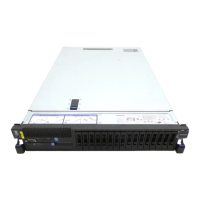Overview
The PCIe-based solid-state drive (SSD) offering consists of a SAS PCIe adapter and an SSD module. The
RAID and SSD SAS adapter is a double-wide, low-profile, short, PCIe x8 adapter that requires two
adjacent PCIe slots. You can plug one, two, or four SSD modules directly onto the adapter and avoid the
use of any SFF, 3.5 inch SAS bays, or any cabling to the SAS disk enclosures.
Though it is physically the same PCIe adapter, there are two feature codes (FC):
v PCIe RAID and SSD SAS Adapter 3 Gb (FC 2053) designates a low-profile PCIe adapter to be used in
the Power 710 Express, Power 720 Express, Power 730 Express, and Power 740 Express low-profile
slots.
v PCIe RAID and SSD SAS Adapter 3 Gb with Blind Swap Cassette (FC 2055) designates that the PCIe
adapter is in a double-wide blind swap cassette for use in a 12X-attached 5802 and 5877 PCIe I/O
drawer.
Though it is physically the same SSD module, two feature codes are used to describe the different
operating system environments. The following are the two codes that enable the IBM configurator tools
to track the different SSD protection rules that are associated with the AIX, IBM i, and Linux operating
systems:
v 177 GB SSD Module with enterprise multi-level cell (EMLC) (AIX or Linux) is FC 1995
v 177 GB SSD Module with EMLC (IBM i) is FC 1996
There are multiple configuration options that provide SSD protection and redundancy. If you want
redundancy at an adapter level, you can mirror the SSD module of one PCIe RAID and SSD SAS Adapter
against the SSD module of another PCIe RAID and SSD SAS Adapter by using the IBM AIX, IBM i, or
Linux operating system. This configuration is suggested because there is no write cache in the PCIe RAID
and SSD SAS Adapter. However, the RAID 5 or RAID 6 can also be used. If you want RAID 0, you must
mirror the SSD module though the operating system. Ensure that if an SSD module requires to be
replaced or moved, the PCIe RAID and SSD SAS Adapter on which the SSD module is located must be
removed from the server or I/O drawer before the SSD module can be accessed. This action is different
from the existing 69 GB SSD configurations, which can use the SAS bay hot-plug capability to remove
and replace a single SSD module without removing the associated PCI SAS adapter.
For the AIX and Linux operating systems, if you do not want to have PCIe RAID and SSD SAS Adapter
redundancy, but still want to protect the SSD module content, the PCIe RAID and SSD SAS Adapter can
provide RAID 5 or RAID-6 level protection on the PCIe adapter. RAID 10 is not supported for the PCIe
RAID and SSD SAS adapter. Hot-spare capability can optionally be used with RAID 5 but the spare SSD
module must be on that same PCIe RAID and SSD SAS adapter.
The following figure shows the adapter.
168 Power Systems: Managing PCI adapters for the IBM Power 710 Express or the IBM Power 730 Express
